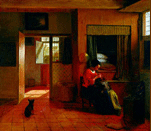










1.
The Construction of Female Theatrical Voices
and Spaces in the Seventeenth Century:
English and Spanish Women Dramatists
Organizers:
Description:
In seventeenth-century Spain and England women were condemned for using public
discourse, hence discouraged from engaging with public theatre. Nevertheless,
a number of early modern Spanish and English women writers took up the genre
of drama. In the workshop we will investigate how early women dramatists created
legitimate spaces for their dramatic utterances by devising strategies and
theatrical settings which helped them to justify female self-expression. We
will explore these legitimising strategies and constructed theatrical spaces
by examining plays by early modern Spanish and English dramatists from a historical-literary
perspective: a wide range of seventeenth-century (con)texts will be considered
in relation to plays by seventeenth-century English and Spanish women, as
well as the history of dramatic production and reception in seventeenth-century
England and Spain, and the generic nature of drama. Thus, the workshop addresses
issues central to the study of Spanish and English history, Spanish and English
literature, drama studies and gender studies.
Introduction and aims
In The English Gentlewoman (1631), a book aimed at the "education of young ladies", Richard Brathwaite alleged:
It suits not with her honour for a young woman to be
p-r-o-l-ocu-t-o-r-...bashful silence is an orna-ment to their [woman's] sex
(The English gentlewoman. The English gentleman and The English gentlewoman Both in One Volume Couched. The 3rd edition. London: John Dawson, 1641. Tt1r-v).
Brathwaite's statement illustrates the notion of woman's voice which dominated social life both in Renaissance England and seventeenth-century Spain. Whereas woman's silence was seen as a mark of proper feminine submissiveness and chastity, a woman who asserted her voice in public was thought to make herself sexually available, drawing attention to her body through her speech. Since female speech was associated with lewd conduct, women were largely discouraged from self-expression.
The social ban on the female voice in seventeenth-century England clearly manifested itself in the exclusion of women from the acting profession before 1660. Although the actress was a common phenomenon on the public stages in Spain, this was not the case in England. Until the first year of the Restoration period, women were officially not allowed to enter the public stage, and female parts were acted out by so-called boy-actors, that is, young, immature men who impersonated women by dressing up in women's attire, and would become strongly involved with the area from which they were socially debarred, namely language. In seventeenth-century Spain women acted on the public stage, but were commonly associated with sexual availability. ' On the other hand, it must be noted that king Philip IV officially publicised his liaison with a famous actress.
Although writing is a less direct medium of self-expression than speech, as a discursive form used by women it was also equated with sexual incontinence. However, the extent to which seventeenth-century English and Spanish women writers risked their sexual reputation depended upon the genres that they took up. Particular genres such as domestic handbooks and translations were considered to be more acceptable for women because their subjects or formats of expression were compatible with the norms of femininity. Obviously, because of its public nature, drama was not among those genres which were deemed suitable for women authors. Thus, the position of the seventeenth-century Spanish and English woman playwright was essentially problematic. How could she construct a public, dramatic voice when such a mode of self-expression was associated with sexual looseness? And how could these women dramatists present a female perspective when the available dramatic generic patterns endorsed the cultural silencing of women?
The aims of this workshop are to explore the ways in which English and Spanish seventeenth-century women playwrights managed to demarcate a theatrical space for their dramatic utterance. In both countries women appear to have been involved in writing drama, as part of an essentially private alternative dramatic counterculture, in which women exchanged their plays with one another. In seventeenth-century England women wrote closet plays, not officially meant to be performed, but designed for reading out either alone or in small groups of female relative and friends within the feminine space of the household. The Spanish convents offered similar opportunity to Spanish seventeenth-century women: various nuns wrote dramatic works in the enclosed circuit of their community. Since the seventeenth-century marked a golden age of drama in both England and Spain, since in both nations the codes of feminine propriety excluded authorship, and since in both countries women participated in a private dramatic tradition, it is valuable to compare and contrast women's position within the field of dramatic production in the two countries. At the same time, women's engagement with dramatic production appears to have been less restricted in Spain where women actresses were a common phenomenon on the public stage than in England where women were excluded from public acting till 1660. A further investigation of whether the greater accessibility of seventeenth-century Spanish women to the public theatre affected the construction of a female dramatic voice can be pursued by comparing Spanish women playwrights' drama with plays written by contemporary English women.
We will read and discuss fragments of two tragedies and two so-called comedias (a Spanish genre which comprised tragic, tragicomic as well as comic plays) by seventeenth-century Spanish and English women writers: Elizabeth Cary's The Tragedie of Mariam (ca. 1604-09), Margaret Cavendish's The Unnatural Tragedy (ca. 1650), Ana Caro's Valor, Agravio y Mujer (ca. 1640) and Leonor de la Cueva y Silva's La Firmeza en el Ausencia (ca. 1640, the latter two accompanied by translations into English). The issues of dramatic forms, public vs. private and the setting of their plays will be analysed. Furthermore, we will investigate how these female dramatists managed to legitimise their self-expression and subsequently create a female dramatic voice. We will do so by examining the gender discourses employed by these women dramatists in the representation of female speaking subjects in their plays and by the ways in which these playwrights have subverted the dramatic conventions used by seventeenth-century playwrights whose work is already familiar to us. Participants from different disciplines can contribute to the discussion by sharing their knowledge of gender constructions in early modern England and Spain, their knowledge of women's writing in general, of the history of drama in Spain and England and of theatrical forms and devices
Structure of the workshop
During the first 20 minutes the subject will be introduced by two of the conveners. We will read fragments from texts illustrating the social context of women and drama in England and Spain. Subsequently, the conveners will give examples of women who became involved in theatrical affairs despite social restrictions: the English queen Anne and queen Henrietta Maria who performed in court masques and plays, and Spanish actresses. Finally, the social context of the women dramatists and their plays will be discussed.
During the next twenty minutes we will discuss of the issue of setting in
the fragments of the three plays read in preparation. Central questions will
be:
a. To what extent are the plays set in a public/ private setting? How do the
settings of the plays reflect the theatrical contexts that were available
to women in England on the one hand, and Spain on the other?
b. In what sorts of settings/contexts do the female characters speak?
c. To what extent does the use of conventions by the female dramatists make
the plays private or public? Which theatrical devices employed suggest privacy
and which suggest publicity? Is there a significant relationship between the
contexts evoked in the plays and the contexts in which these women wrote their
plays or had their plays consumed?
d. Are their significant differences between the Spanish and English women
dramatists as far as their choice of contexts and settings is concerned?
During the subsequent twenty minutes we will examine the issue of woman's
speech in the fragments of the three plays read in advance.
Central questions will be:
a. Do the women playwrights confirm or subvert the dominant ideologies on
woman's speech? To what extent do they engage with discourses of religion,
class, motherhood, sexuality, friendship in their construction of a legitimate
female dramatic voice?
b. What strategies do these dramatists employ in legitimising woman's public
utterance. Are they analogous to the strategies used by women writers in other
genres? What are significant similarities or differences and what do they
have to do with the nature of drama?
c. Are the strategies employed by Spanish women dramatists different from
these adopted by the English women dramatists?
During the next 25 minutes we will discuss the issue of dramatic conventions
in the three plays, exploring the ways in which English and Spanish women
dramatists have rewritten dramatic generic codes in the process of legitimising
female public expression.
Central questions will be:
a. To what extent do the closure of the plays differ from the endings of contemporary
English tragedies and Spanish comedias that we know? Is there any relation
to the ways in which the women structure the endings of their plays and their
subversion of gender roles?
b. Compare and contrast the representation of woman's speech and the depiction
of man's speech at the dramatic conclusion. Which theatrical devices or generic
codes play a role in these representations.
c. What is the significance of the absence/presence of women's bodies and
voices on the (imaginary) stage at the tragic closure of the English plays
or the conclusion of the Spanish comedias?
d. To what extent do the female characters transcend death?
This will be followed by a conclusion of the discussion by two of the conveners.
The central focus will be whether there are similarities and differences between
the plays written by the English women dramatists on the one hand, and the
Spanish female playwrights on the other. To what extent can any differences
be attributed to the different national contexts, or to the different gender
roles available to English women on the one hand and Spanish women on the
other hand in relation to drama?
Preliminary list of readings:
Cary, Elizabeth. The Tragedie of Mariam. In: Cerasano, S.P. and Marion Wynne-Davies. Renaissance Drama by Women: Texts and Documents. Act I, scene i. (page 50; Mariam's opening speech), and Act V (pp. 71-75).
Caro, Ana. Valor, Agravio y Mujer. Ed. Lola Luna. Madrid: Castalia, 1993. Act I, pp. 97-99 en Act III, pp. 159-164. With English translations.
Cavendish, Margaret. The Unnatural Tragedy. In: Playes; Written by the Thrice Noble, Illustrious, and Excellent princess the Lady Marchioness of Newcastle. London: A. Warren for John Martyn, James Allestry, and Tho. Dicas,1662. Act I, scene 7 and act V.
Cueva y Silva, Leonor de la. La Firmeza en el Ausencia. In: F. González Santamera en F. Doménech (eds.), Teatro de mujeres del Barroco. Madrid: Publ. de la Asociación de Directores de Escena de España, 1994. Act II, pp. 284-285, 300- 303, en Act III, pp. 310-311. With English translations.
|
|
|
||||||
|
|
 |
 |
|
||||
 |
|
 |
|
||||
|
|
|
||||||
|
|
|
||||||
 |
|
||||||
|
|
|
||||||
| |
|
||||||
 |
|
||||||
 |
|
||||||
 |
|
||||||
 |
|
||||||
|
|
|
||||||
|
|
 |
|
|
||||
 |
|
||||||
|
|
|
|
|
|
|
|
|